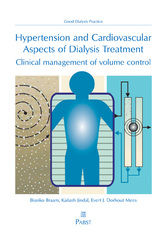Suchen und Finden
Service
Hypertension and Cardiovascular Aspects of Dialysis Treatment - Clinical management of volume control
Branko Braam, Kailash Jindal, Evert J. Dorhout Mees
Verlag Pabst Science Publishers, 2011
ISBN 9783899677218 , 192 Seiten
Format PDF
Kopierschutz Wasserzeichen
Geräte
Table of contents
6
Preface
10
Foreword to the first edition „Cardiovascular aspects of dialysis treatment“
11
Preface to the first edition „Cardiovascular aspects of dialysis treatment“ by Evert J. Dorhout-Mees
12
1. Synopsis of the physiological regulation of extracellular fluid volume and blood pressure
15
1.1 Water, salt and body fluid volumes
15
1.2 Regulating mechanisms of osmolality and ECV in normal man
20
1.3 The relationship between extracellular fluid volume, blood volume and blood pressure
23
1.4 The renal function curve
26
Summary
27
Bibliography
27
2. End stage renal disease
28
2.1 The aim of dialysis treatment
28
2.2 When is dialysis treatment adequate
29
2.3 The KT/V concept and its limitation
32
2.4 Control of the extracellular fluid volume in dialysis patients
33
2.5 Consequences of extracellular fluid volume expansion
37
2.6 The dry weight concept
42
2.7 Assessment of the volume status in hemodialysis patients
44
Summary
49
Bibliography
49
3. Hypertension and survival in dialysis patients
52
3.1 Prevalence of hypertension
52
3.2 Which blood pressure is representative?
54
3.3 Hypertension and survival
55
3.4 What is the optimal blood pressure?
58
Summary
59
Bibliography
60
4. Pathophysiology of Hypertension in dialysis patients
61
4.1 Volume expansion is the key
61
4.2 The renin-angiotensin system
67
4.3 The Sympathetic Nervous System
70
4.4 Other hypertensive mechanisms
71
4.5 Paradoxical hypertension
72
Summary
73
Bibliography
74
5. Treatment of Hypertension in dialysis patients
75
5.1 General strategies for volume control
75
5.2 Decreasing salt intake
75
5.3 Conventional hemodialysis and volume balance
76
5.4 Increasing volume removal by frequency of dialysis sessions
76
5.5 Increasing volume removal by increasing ultrafiltration duration
78
5.6 Antihypertensive drugs
79
5.7 Diuretic use in dialysis patients
81
Summary
82
Bibliography
82
6. Dialysis Hypotension
83
6.1 General considerations
83
6.2 Symptoms of dialysis hypotension
84
6.3 Pathogenesis of dialysis hypotension
86
6.4 True hypovolemia
86
6.5 The dialysis procedure
91
6.6 The ‘uremic state’: Are circulatory responses to the decrease in blood volume disturbed?
94
6.7 Cardiac functions
94
6.8 Concluding remarks regarding intradialytic hypotension
96
6.9 Sustained chronic hypotension
98
Summary
99
Bibliography
100
7. Heart disease in dialysis patients
102
7.1 General considerations, risk factors
102
7.2 Methods of investigation
103
7.3 Cardiac Dilatation
110
7.4 Left ventricular hypertrophy
111
7.5 Congestive heart failure
118
7.6 Valvular disease
121
7.7 Dilated cardiomyopathy of end-stage renal disease
124
7.8 Sudden Cardiac Death (SCD) and Arrhytmias
129
Summary
131
Bibliography
132
8. Vascular disease in dialysis patients
134
8.1 Ischemic heart disease
134
8.2 Arterial stiffening and systolic hypertension
137
8.3 Peripheral artery disease
142
8.4 Stroke
142
8.5 Venous changes
143
Summary
143
Bibliography
143
9. Peritoneal Dialysis
145
9.1 Introduction
145
9.2 Cardiovascular complications and risk factors
146
9.3 Hemodynamic and cardiac status
147
9.4 Treatment of overhydration in peritoneal dialysis patients
149
9.5 Why does peritoneal dialysis not provide better cardiovascular results?
152
9.6 Lack of volume control
153
Summary
154
Bibliography
155
10. Special considerations
156
10.1 Effusions in serous cavities
156
Summary
161
10.2 Renal anemia and erythropoietin therapy
161
10.3 Malnutrition in ESRD
167
10.4 Recent views about sensing, distribution and cellular actions of salt
172
Summary
175
Bibliography
176
11. Final considerations and future perspectives
178
11.1 Quality of life
178
11.2 Evidence-based medicine and controlled trials
180
11.3 Care of the dialysis patient by the dialysis team
181
11.4 Practical considerations
182
11.5 Future perspectives
183
11.6 Pathophysiological problems in hemodialysis research to be resolved
185
11.7 Comeback of clinical research
187
Bibliography
187
Index
189
Service
Shop











